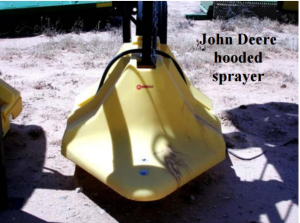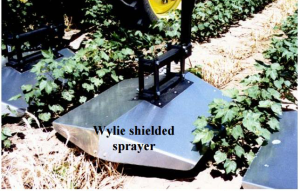by Emi Kimura and Gaylon Morgan
Cotton is a slow growing plant and is typically grown on wide row spacing. Because of these reasons and others, cotton requires well planned weed control program, including cultivation, pre-plant (burndown and incorporated), pre-emergence, and post-emergence (directed and over-the-top) herbicide applications. Lint yield can be lost by 13-54% when 1 to 10 Palmer amaranth plants are present at every 30 ft of row, respecitvely (Morgan et al., 2001). The length of pre-emergence herbicide activity varies by herbicide, rate, soil moisture, soil texture, soil organic matter, and pH. Even when the pre-emergence herbicides are applied, scouting for weed emergence to determine the need for post-emergence control, especially if glyphosate resistant pigweeds are expected. Glyphosate resistant pigweeds and other problematic weeds are most effectively controlled as small seedlings.
Mid-season weed pressure is high this year due to the good rainfall this spring and summer and high weed seed density in the soil. Mid-season weed control is important to preserve yields, but also to avoid further accumulation in the soil weed seed bank. There are two major weed management practices recommended for mid-season weed control.
Cultivation: Cultivation is an effective method to control small annual weeds and reduce competition from  perennial weeds for a limited time. Shallow cultivation is recommended to minimize the damage on cotton roots. When plowing perennial weeds, equipment should be cleaned thoroughly to avoid spreading weeds to other areas of the field by weed rhizomes, roots, or seeds.
perennial weeds for a limited time. Shallow cultivation is recommended to minimize the damage on cotton roots. When plowing perennial weeds, equipment should be cleaned thoroughly to avoid spreading weeds to other areas of the field by weed rhizomes, roots, or seeds.
Herbicides: Post-directed herbicide application should be made in timely manner to control small weed seedlings with using hooded/shielded or direct sprayer. Weed seedlings should be smaller than the cotton height to avoid herbicide injury. Many post-direct  herbicides are burndown type herbicides although there are some with soil residual activity. Approximate timings of the post-directed herbicide applications are cotton seedlings at 3 to 8-in height and at 8 to 14-in height. Available products of post-directed herbicide are summarized in the Table 1.
herbicides are burndown type herbicides although there are some with soil residual activity. Approximate timings of the post-directed herbicide applications are cotton seedlings at 3 to 8-in height and at 8 to 14-in height. Available products of post-directed herbicide are summarized in the Table 1.
All products differ for their timing of applications, targeted weeds, and rate of application. In many cases, a combination of herbicides should be considered to provide post-emergence activity, but also some soil residual activity.
Excessive rainfall observed this year has caused reduced efficacy from pre-emergence herbicide controls in cotton, which minimizes the cotton to weed height differential. Without the enough height differential between cotton and weed, over-the-top herbicide application is the appropriate weed control measure and application efficiency. Depending on the herbicide, over-the-top application will control or injure weeds and will create the height differential for effective post-directed herbicide applications. Over-the-top herbicide products for cotton are summarized in the Table 2. For the detailed information on target weeds, rates, and application timing of these products, please refer the Weed Management in Texas Cotton.

Assistant Professor and Extension Agronomist-Vernon, TX
emi.kimura@ag.tamu.edu

